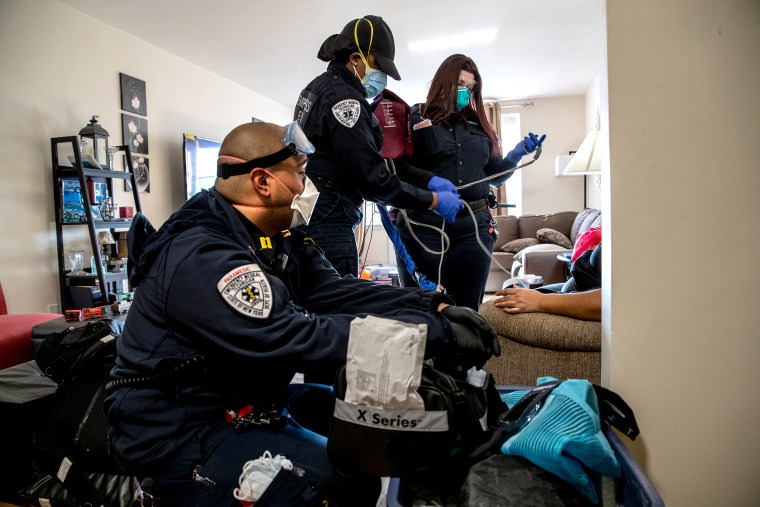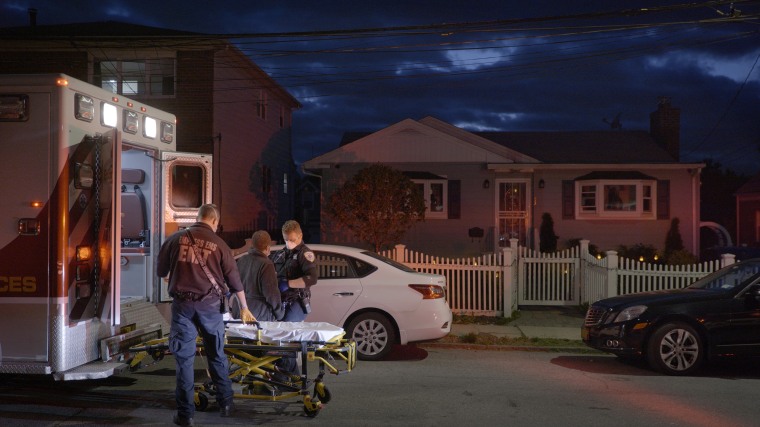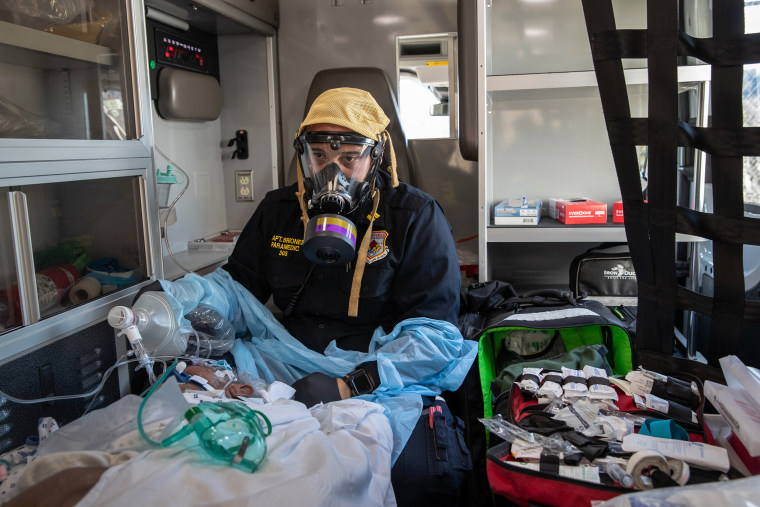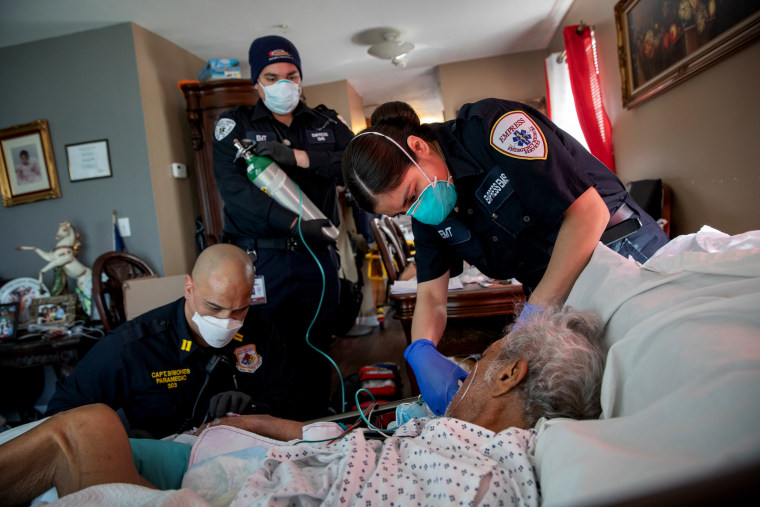At the height of the coronavirus pandemic in New York, emergency medical services Capt. AJ Briones' teams were fielding nearly 700 calls a day, tending to numerous patients going into cardiac arrest, many others needing intubations and seeing more deaths than they ever intended to see.
“We didn’t know that would be the end of life as we know it,” Briones, 32, who works for Empress Emergency Medical Services in Yonkers, Westchester County, said. “It literally shut down the whole world.”
Now with cases down in the state, his EMS teams can sometimes catch their breath for a moment. But with cases rising rapidly around the country, Briones reflected on the virus' devastating toll, how far New York has come and his concerns about a possible second wave in the state.

Before the pandemic swept through, Briones said their typical call volume was somewhere around 300 to 400 calls a day, but during the peak, calls doubled at times.
“We did a month's worth of cardiac arrests in three days, three months worth of intubations in three days," he said. "It was really a hard time for anybody. I don't care how seasoned you were."
Facing death, time and time again
Westchester County’s first known coronavirus case came March 3, a day Briones said he will never forget.
“When we first saw that, kind of all of our hearts stopped,” he said while wearing a mask and a dark blue uniform. “And from there, it just became a whirlwind.”
During some of those calls, families with very sick patients faced tough questions. One question Briones had to ask patients over and over was, “If you stop breathing, do you want me to put you on a ventilator?” Sometimes the patients were unable to answer and their families did not know what to do.
While wearing an N95 mask and goggles, and toting a hulking backpack full of medical equipment and an electrocardiogram machine, Briones often had a refrain he would use to reassure his patients, telling them, “96 percent of people survive this.”

One lesson, he said, he would take away from the pandemic was, “Don't ever wait to have that talk with your family about what you would want if something were to happen.”
Back then, what would normally be a 12-hour shift beginning at 8 a.m. could easily turn into long nights lasting until 2 a.m. or even later. Among themselves, the EMTs never said the “Q word,” meaning it was a “quiet” shift, worried they would soon be bombarded with calls again.
Briones said the peak of the pandemic took a mental toll on his teams, having to deal with so much death and devastation as the first epicenter of the outbreak in the country.
“Everybody here was affected by it, not just because of the job we did, but they had a family member, they had a friend or they had somebody that died or was critically ill from it,” he said. “One of our EMTs lost five family members in a 48-hour period.”
Some of the hardest moments were seeing the effect it took on his personnel, Briones said. Empress Emergency Medical Services has some 600 EMTs and paramedics and about 75 nonclinical staff serving Westchester and parts of New York City, he said.

While his team knows death comes with the job, Briones said, “It gets rough, we've seen way more death than any of us have ever planned to see.”
“You can never get away from that trauma. Our patients will not all live,” he said.
But Briones said it was also difficult to have to tell families that their loved ones were not going to make it over and over again.
“Knowing I'm taking this person out of this house and this is the last time their family is going to see them before their funeral,” he said. “Knowing that we're going to do everything that we can, but everything we can sometimes isn't enough. And it's something that we come to grips with sometimes once or twice a week — not that many times a shift.”
'We don’t know when the end is'
Briones compared the outbreak to a mass casualty incident.
“You learn about mass casualty incidents and that’s what this is,” he said. “We’ve had a lot of patients over a really long time, that stresses the system, and we don’t know when the end is.”
In April, Briones met a man named Cecil Jenkins, who was suspected of having the coronavirus and had just lost his wife to the disease days before.
Now, he too had the familiar symptoms, including a fever and difficulty breathing. Fearing he was also going to die from the virus, he called the EMS service.
“I just lost my wife to COVID-19, so I’ve been crying,” Jenkins, 68, said, breaking down in tears outside his home, wearing a black hat, a white mask and blue gloves.
Briones put a gloved hand on the man’s arm and comforted him as he took his vitals.

“You lost someone very close to you,” Briones later told Jenkins from inside the ambulance as he continued to assess his patient. “That’s not an easy feat. We don’t know what she was to you. ”
“She was the one,” Jenkins said.
Those types of interactions, Briones said, are hard.
"A lot of that call was being his therapist,” he said. “Helping him work through what he's going through.”
Because of his constant exposure to the virus, Briones chose to remain isolated from those he could expose to the illness, especially his parents.
After one long shift, he disinfected himself before sat down at a table and called them on FaceTime.
“We are very proud of you, son. We love you,” his mother, Agnes, said. "So many people are praying for your team.”
“I love you, too,” Briones said to his mother and father.
'Will we know that what we did worked?'
After fielding the surge in calls for months, New York finally began taking a turn for the better in mid-May as cases started to decrease.
But cases are continuing to reach record highs in other states across the country, with total coronavirus cases surpassing 4.2 million and deaths totaling more than 146,000 as of Monday. And the daily coronavirus death toll in the country has topped 1,000 four times within the past month, suggesting that the decline in deaths seen in May and June is reversing.
When New York City finally made it into phase four of its reopening last week, Briones said it was not something he could picture given the intensity of the pandemic in the state at its peak.
Even though cases are still on the decline in the state, he said there's a fear of a second wave.

“Looking out now and looking around, it's refreshing and terrifying all at the same time,” Briones said. “Will we know that what we did worked? Or will we be right back to where we started? And that's the terrifying part.”
Briones said he has been hearing from EMS personnel in states with rising cases, including from Federal Emergency Management Agency personnel who aided New York during its initial outbreak.
“We try to help everybody else as much as possible and this is one of the greatest information sharing things I've seen in my career in EMS,” he said.
He told a new class of EMTs in training in May: “You’ll have moments where you’ll question your own abilities — and perhaps your own sanity — but you’ll rise."

